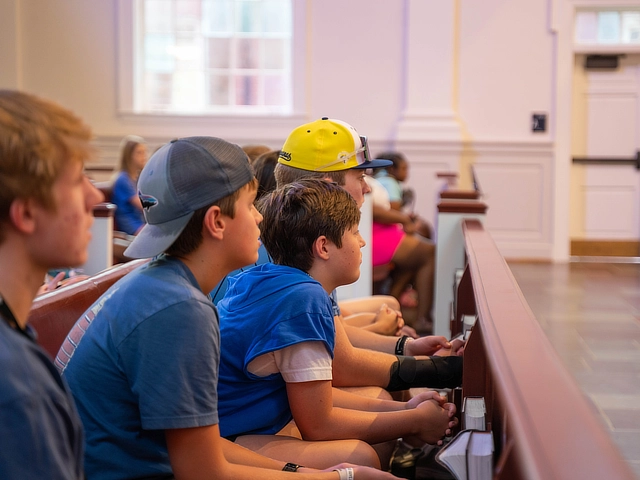
This is part two of a five-part series on our learning about young people at Animate. If you missed part one, you can find it here.
Last summer at Samford while Animate 2023 was taking place, a team of four researchers conducted focus groups and informational interviews with almost all of our teenage participants.
There were thirty-five people who participated in the study. Among these thirty-five, there was diversity in gender, in denominational representation (including Baptists, Presbyterians, Methodists, Nondenominational, and one Roman Catholic), and in racial and ethnic composition.
We had three different focus groups that each met two times over lunch for about thirty minutes—one girls group, one boys group, one all-genders group, all groups totaling eighteen people. The other seventeen students participated in one-on-one informational interviews for about fifteen minutes. All of this was bookended by introductory and exit surveys.
Given the small sample size, this research offers an important micro-view of teenagers and their experience of liturgical difference. We believe this is important, given how many macro assumptions exist regarding teenagers and their worship preferences.
For instance, while it is often assumed that teenagers prefer the musical expressions of contemporary worship, is this actually true? Further, do young people sincerely desire their own worship gatherings, separate from the all-church ones that include adults and children? Is what goes on at a worship camp experience—including our own—preferred by young people, over that of their home church contexts? Our study does not suggest that all these assumptions and questions are misguided or inaccurate. However, we are interested in demonstrating that there is richer complexity than meets the ear or eye.
Our programming and research angles are inspired by larger conversations around youth and religion, such as the landmark National Study of Youth and Religion, but also more recent research on Generation Z religiosity through the Springtide Research Institute, and the American Survey Center. According to the 2021 American National Life Survey, younger Americans aged 18 to 29—Gen Z and Millennials—are disaffiliating from their religious traditions at a younger age than older adults (of those who disaffiliate, 48% disaffiliate between ages of 13 to 17).
Certainly, there is no “silver bullet” for young adults to keep their faith beyond their teenage years. According to research from the Fuller Youth Institute, what comes closest, though, is attendance at churchwide worship service with all generations present. This is consistent with some of the findings of the National Survey of Youth and Religion in that “cross-generational relational ties” can “help legitimize and reinforce the religious faith and practices of those teens.” That same study indicates that 61% of young adults crave those cross-generational ties.
These are the numbers stirring our work with young people. The Animate program is energized by the pastoral concern for teenagers to stay connected to a faith community as they move into adulthood. This is why Animate empowers them to lead, and why this learning takes place intergenerationally.
Next up in this series, we will share more about our research findings from our work with teenagers at Animate. For more information about Animate, as well as a chance to register your interest in Animate 2024, please visit our website.
Emily Snider Andrews, PhD, is Assistant Professor of Church Music and Worship Leadership and Executive Director of the Center for Worship and the Arts at Samford University.
Rev. Nelson Cowan, PhD, Director of the Center for Worship and the Arts at Samford University, is a liturgical theologian, worship leader, and ordained pastor in The United Methodist Church.
